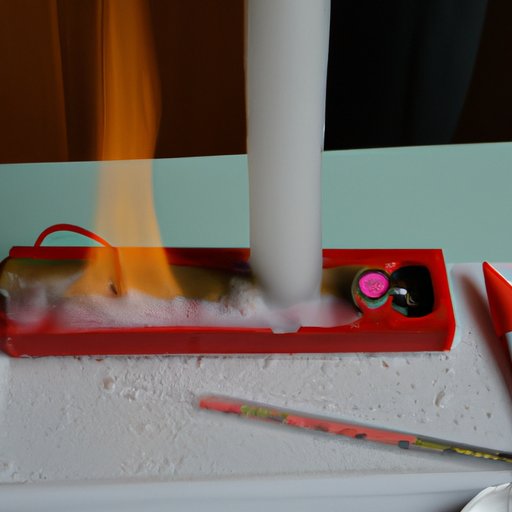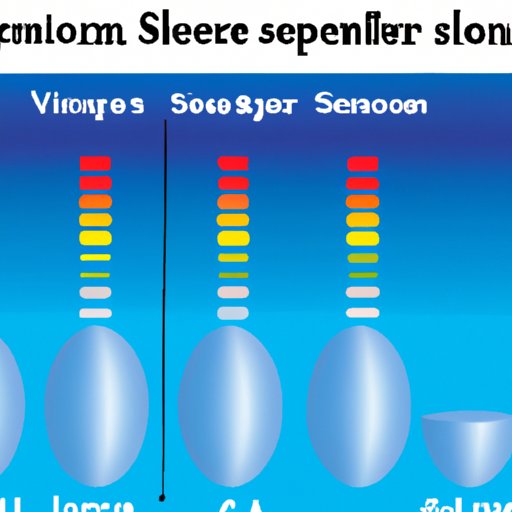Introduction
Sound is a vibration that travels through a medium such as air or water. Its speed depends on the properties of the medium, such as temperature and pressure. This article will explore the speed of sound in different environments, how temperature affects it, and the history behind discovering its velocity.
Analyzing the Speed of Sound in Different Environments
The speed of sound is determined by the physical properties of the medium through which it travels. For example, the speed of sound in air is affected by the temperature and pressure of the environment. In order to understand how the speed of sound varies across different mediums, we must first examine the physics of sound propagation.
When an object vibrates, it produces a wave of sound energy that propagates outward in all directions. The speed of sound is determined by the elasticity and density of the medium. As the wave passes through the medium, it transfers energy to the molecules of the medium, causing them to vibrate. This vibration then causes the molecules to “bump” into each other, transferring energy from one molecule to the next and creating a chain reaction.
The speed of sound in air is about 343 meters per second (1,126 feet per second) at sea level and 0° Celsius (32° Fahrenheit). In comparison, the speed of sound in water is approximately 1,484 meters per second (4,876 feet per second) and the speed of sound in a vacuum is zero. These differences are due to the varying densities of the mediums.

Exploring the Impact of Temperature on the Speed of Sound
Temperature plays an important role in determining the speed of sound. As the temperature of a medium increases, the molecules within it become more active, resulting in increased collisions and a greater transfer of energy. This increase in energy leads to an increase in the speed of sound.
The relationship between temperature and the speed of sound can be expressed mathematically using the equation v = sqrt(γRT), where v is the speed of sound, γ is the adiabatic index, R is the universal gas constant, and T is the absolute temperature. This equation shows that as the temperature of a medium increases, the speed of sound also increases.
In addition to temperature, other factors such as humidity, pressure, and altitude can affect the speed of sound. Humidity is especially important because it affects the density of air, which in turn affects the speed of sound. Higher levels of humidity lead to a decrease in the speed of sound, while lower levels of humidity lead to an increase in the speed of sound.
A Historical Perspective on The Discovery of Sound’s Speed
The discovery of the speed of sound is attributed to Italian physicist Evangelista Torricelli, who conducted experiments in 1644 involving sound waves and water. He found that sound waves travel faster through water than through air, leading him to conclude that the speed of sound depends on the density of the medium. His findings were later confirmed by French scientist Pierre-Simon Laplace in 1745.
In 1738, British physicist Robert Hooke proposed the idea of measuring the speed of sound using two observers and a cannon. By timing the interval between when the cannon was fired and when the observers heard the sound, he was able to calculate the speed of sound. This experiment was repeated by Norwegian scientist Christian Doppler in 1848, who used a whistle instead of a cannon.
In the 19th century, German physicist Hermann von Helmholtz developed an equation to calculate the speed of sound based on the temperature and pressure of the medium. His equation was later refined by American scientist Robert E. Chilton in 1895. Chilton’s equation is still used today to calculate the speed of sound in various environments.
Conclusion
This article has explored the speed of sound in different environments, how temperature affects it, and the history behind discovering its velocity. We have seen that the speed of sound in air is affected by temperature, pressure, and humidity, while the speed of sound in water and a vacuum is determined by their respective densities. We have also discussed historical milestones in understanding the speed of sound.
Although much progress has been made in understanding sound’s speed, there is still much to be learned. Further research could focus on exploring the effects of other factors such as altitude and pressure on the speed of sound. Additionally, new methods of measuring the speed of sound could be developed.
(Note: Is this article not meeting your expectations? Do you have knowledge or insights to share? Unlock new opportunities and expand your reach by joining our authors team. Click Registration to join us and share your expertise with our readers.)
